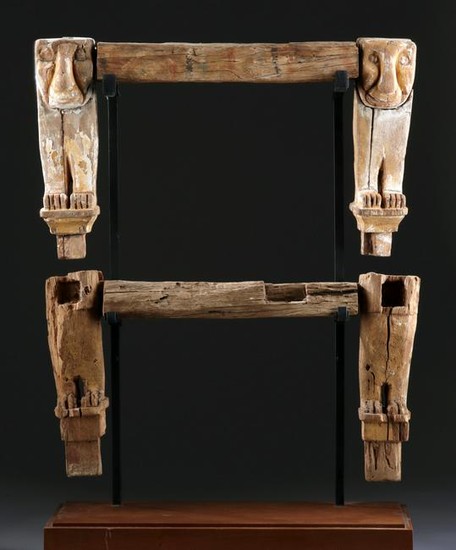Egyptian Late Dynastic Wood Chair Legs w/ Lions
Ancient Egypt, Late Dynastic period, ca. 664 to 332 BCE. Carved wooden legs, perhaps from a throne, an auxiliary royal seat, or a stool intended for a statue of a divinity. According to Nora Scott, former Associate Curator of Egyptian Art of the Metropolitan Museum of Art, lions were depicted, because it was thought that the sitter shared and/or derived qualities from the courageous King of Beasts. She also notes that the "spool-like supports under the animal hooves or paws were originally placed there, perhaps, to raise them above the sandy floor and to increase their importance by separating them from the ground." These legs not only still possess remarkable detailing of the wild felines' eyes, nose, muzzle, and paws, but they also present traces of gesso as well as red and black pigment, suggesting that they were once lavishly decorated. Size: 20.5" W x 24.625" H (both legs as arranged) (52.1 cm x 62.5 cm); 30.25" H (76.8 cm) on included custom stand.
Perhaps the most famous ancient Egyptian chair was King Tut's Throne - among the most luxurious treasures discovered by Howard Carter in 1922. It is oftentimes referred to as Tut's Golden Throne; however, this may be a misnomer as scholars believe that the seat was actually an auxiliary royal chair rather than the boy king's throne. Interestingly, the so-called King Tut Throne was not made of solid gold as some have surmised, but rather was comprised of wood overlaid with sheets of precious gold and silver and further decorated with glaze, colored glass, and semi-precious stones. Given this, just imagine how these wooden legs were once adorned!
For more discussion of Egyptian furniture read an article by former Associate Curator of Egyptian Art Nora Scott entitled "Our Egyptian Furniture" (Metropolitan Museum of Art Bulletin, Volume XXIV, Number 4, December 1965). A miniature bronze model throne for a deity with legs depicting lions in the front and lion legs in the rear in the collection of the Metropolitan Museum of Art (accession number 64.308) is illustrated in this article as well (p. 148, figure 49).
Provenance: private J.H. collection, Beaverton, Oregon, USA; ex-Relics of the Nile, Lexington, Kentucky, USA; with Harlan J. Berk Ltd: Ancient Coins and Antiquities 118th Buy or Bid Sale – 17 January 2001, lot 766
All items legal to buy/sell under U.S. Statute covering cultural patrimony Code 2600, CHAPTER 14, and are guaranteed to be as described or your money back.
A Certificate of Authenticity will accompany all winning bids.
We ship worldwide to most countries and handle all shipping in-house for your convenience.
#149599 Dimensions: Condition Report: Expected age wear with age cracks, areas of inactive insect loss, loss to pigment and decoration, losses to peripheries and high-pointed areas as shown. This said, it is remarkable that these legs have survived with the level of detail that they possess given that they are made of wood.
View it on
Estimate
Time, Location
Auction House
Ancient Egypt, Late Dynastic period, ca. 664 to 332 BCE. Carved wooden legs, perhaps from a throne, an auxiliary royal seat, or a stool intended for a statue of a divinity. According to Nora Scott, former Associate Curator of Egyptian Art of the Metropolitan Museum of Art, lions were depicted, because it was thought that the sitter shared and/or derived qualities from the courageous King of Beasts. She also notes that the "spool-like supports under the animal hooves or paws were originally placed there, perhaps, to raise them above the sandy floor and to increase their importance by separating them from the ground." These legs not only still possess remarkable detailing of the wild felines' eyes, nose, muzzle, and paws, but they also present traces of gesso as well as red and black pigment, suggesting that they were once lavishly decorated. Size: 20.5" W x 24.625" H (both legs as arranged) (52.1 cm x 62.5 cm); 30.25" H (76.8 cm) on included custom stand.
Perhaps the most famous ancient Egyptian chair was King Tut's Throne - among the most luxurious treasures discovered by Howard Carter in 1922. It is oftentimes referred to as Tut's Golden Throne; however, this may be a misnomer as scholars believe that the seat was actually an auxiliary royal chair rather than the boy king's throne. Interestingly, the so-called King Tut Throne was not made of solid gold as some have surmised, but rather was comprised of wood overlaid with sheets of precious gold and silver and further decorated with glaze, colored glass, and semi-precious stones. Given this, just imagine how these wooden legs were once adorned!
For more discussion of Egyptian furniture read an article by former Associate Curator of Egyptian Art Nora Scott entitled "Our Egyptian Furniture" (Metropolitan Museum of Art Bulletin, Volume XXIV, Number 4, December 1965). A miniature bronze model throne for a deity with legs depicting lions in the front and lion legs in the rear in the collection of the Metropolitan Museum of Art (accession number 64.308) is illustrated in this article as well (p. 148, figure 49).
Provenance: private J.H. collection, Beaverton, Oregon, USA; ex-Relics of the Nile, Lexington, Kentucky, USA; with Harlan J. Berk Ltd: Ancient Coins and Antiquities 118th Buy or Bid Sale – 17 January 2001, lot 766
All items legal to buy/sell under U.S. Statute covering cultural patrimony Code 2600, CHAPTER 14, and are guaranteed to be as described or your money back.
A Certificate of Authenticity will accompany all winning bids.
We ship worldwide to most countries and handle all shipping in-house for your convenience.
#149599 Dimensions: Condition Report: Expected age wear with age cracks, areas of inactive insect loss, loss to pigment and decoration, losses to peripheries and high-pointed areas as shown. This said, it is remarkable that these legs have survived with the level of detail that they possess given that they are made of wood.



